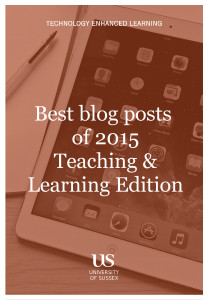
flickr photo by .christoph.G. shared under a Creative Commons (BY-ND) license
Would you like to create your own Ebook? In this post we look at the benefits of Ebooks and share some tips on how to create your own.
Why create an Ebook for teaching and learning?
Ebooks offer advantages over paper books in that they can offer a more dynamic experience to the reader through the ability to include hyperlinks and multimedia within the text. They can be updated easily too, are free to publish and can be easily shared and distributed. A digital format can be an engaging and mobile way to present new material to students.
The TEL team created ‘Best blog posts of 2015, Teaching and Learning Edition’. To date, the EPUB version alone has been downloaded 137 times.

Download the TEL Ebook here
Ebooks for teaching and learning
There are a number of innovative ways to incorporate Ebooks into teaching and learning. Take a look below for inspiration.
- Collate the best. With the permission of students, you could compile the best work, for example, the best dissertations of the year, into an Ebook format for students and parents to download.
- Run a Book Sprint. You could run a subject-specific Book Sprint – an intense writing period of normally five days to produce a ‘ready to publish’ Ebook in your specialism. Book Sprinters recommend using BookType although alternative software is available to use for other forms of collaborative work.
- Make an Ebook an assignment. You could make an Ebook a formative assignment and ask students to collaborate together to write in response to a recent subject. Use Papyrus, Microsoft Office 365 or Google docs. Students can then peer review each other’s work.
- Present information in a new way. Make your module handbook information available as an Ebook that students could download – complete with a glossy cover (made for free using Canva). Make your Ebook available to download from within the virtual learning environment (VLE). In Study Direct you can do this via Add resources and then add file.
- Provide ‘sociable’ text. Enable student communication in the text you recommend reading. Most Ereaders and Ereader apps allow you highlight and annotate. See the list of different ereader apps.
- Project your Ebook and jointly annotate! You could project the Ebook during a seminar and jointly annotated with input from students to help improve understanding of course materials and to help develop critical reading skills. For more information please read ‘Digital devices take reading back to its social roots’ from the TEL Blog.
- E-author? Create your own Ebook, for example, a collection of your articles or blog posts and publish as a collection to promote your research to a wider audience.
There are lots of tools that you can use to write collaboratively. You could use Office 365 or Google docs – both are online and allow for a number of students to access and work on a document simultaneously. This could be used within a teaching context for group-work or peer-review activities where students work collaboratively as a pair, group or class to write and review each other’s writing.
How to publish your Ebook

flickr photo by mediamolecule shared under a Creative Commons (BY-NC-ND) license
Publishing an Ebook, in theory, should be quite simple. If you are completely new to Ebook publishing, however, you might benefit from these suggestions to help you to successfully publish your first Ebook.
- Write the contents of your Ebook in a Microsoft Word document. Ensure that you use the formatter in Word to format your document (that means that your formatting can be read like a webpage, which is what an Ebook essentially is).
- Download the free Ebook Converter software Calibre to your computer. Select the format outputs that you want for your Ebook. Below you will find the various digital formats of Ebooks. You will need to convert your document to one of these in order for it to be read on a digital device. You may be familiar with some of the terms if you already have an Ebook reader.
- In Calibre, click on add your book to locate your document and upload it to Calibre, then select convert and finally choose save to disc. Your document will now be converted into a version that is readable by Ebook readers and saved in a folder for you.
- If you would like an Ebook cover, you can add one to Calibre. You can use Canva to create a free Ebook cover.
A guide to formats
Here is a guide to the most common Ebook formats that you will find referred to when creating an Ebook. You can publish in one of the formats, or all.
- EPUB stands for electronic publication. EPUB is the most widely supported open format and is fast becoming the industry standard for Ebooks. It is XML based.
- MOBI is an Ebook format created by a French company that created Mobipocket. It has been bought by Amazon and MOBI is the only file that can be read by Kindle. It is XML based.
- PDF (Portable Document Format) is one of the oldest Ebook formats. It will present a document independently from an application, software or hardware. PDF is not XML based.
Accessible for all
If you are worried that students might not have an Ereader to read Ebooks on, you will be pleased to know that there are apps that enable users to read Ebooks on their phone, without the need for a special device. If you don’t have a Kindle, you can still read Ebooks via the Kindle app.
If you would like any help creating an Ebook, please get in touch with your School Learning Technologist.



[…] Read the full story by University of Sussex Technology Enhanced Learning Blog […]